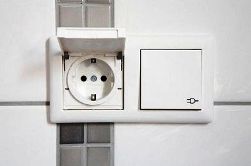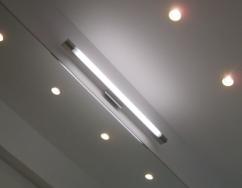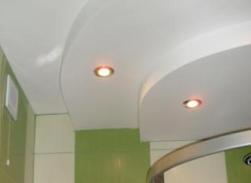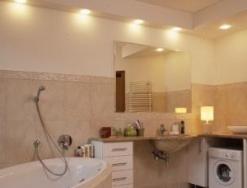Categories: Featured Articles » Electrician at home
Number of views: 109053
Comments on the article: 11
Power supply and bathroom lighting
 According to the classification adopted in the PUE, the bathroom in any apartment is, if not particularly dangerous, at least a room with increased danger. This means that the likelihood that a person will be shocked in the bathroom is high, and the consequences in the event of such a shock will be more severe.
According to the classification adopted in the PUE, the bathroom in any apartment is, if not particularly dangerous, at least a room with increased danger. This means that the likelihood that a person will be shocked in the bathroom is high, and the consequences in the event of such a shock will be more severe.
Higher danger implies greater responsibility and requires us to take additional safety measures when installation and wiring of the bathroom. For rooms with increased danger, the following measures are recommended:
- protective grounding, the introduction of a third, protective conductor PE;
- use of protection devices against leakage currents - RCD or differential circuit breakers.
For bathrooms, both measures are mandatory. Many also consider the requirement for a hidden electrical wiring device in the bathroom. However, there is one caveat in the EMP in this regard, according to which open wiring in rooms with increased danger is allowed if a special cable that has undergone special certification is used.
In any case, beloved by all electricians VVGng cable for open wiring in the bathroom is not suitable, so it is better to opt for hidden wiring. Moreover, it looks aesthetically pleasing.
 So, the wiring is hidden. Lighting circuit - VVGNG 3 * 1,5 cable, socket circuit - VVGNG 3 * 2,5 cable. To lay the cable, the walls can be drilled, or you can simply fix the cable on the wall before tiling. You can use ordinary wall plugs for this. The tile adhesive is usually thick enough to hide the flat cable underneath.
So, the wiring is hidden. Lighting circuit - VVGNG 3 * 1,5 cable, socket circuit - VVGNG 3 * 2,5 cable. To lay the cable, the walls can be drilled, or you can simply fix the cable on the wall before tiling. You can use ordinary wall plugs for this. The tile adhesive is usually thick enough to hide the flat cable underneath.
If a slatted or stretch ceiling is supposed in the bathroom - this, of course, is only at hand for us. Firstly, you can set beautiful Spotlightsmaking the lighting as uniform as possible. And secondly, without bothering yourself, you can lay the cable for these lamps on the ceiling in corrugated pipesecuring it to clips or mounting strips.
By the way, a variety of boxes, often mounted in the bathroom to conceal plumbing communications, are also quite suitable for mounting the cable in them all in the same corrugation.
To have junction boxes in the bathroom should not be, with the exception of the box included in the potential equalization system, which will be discussed below.
If possible, it is better not to have switches in the bathroom. However, if you really need it, the switch in the bathroom should:
- have a degree of protection of at least IP44;
- be located at a distance from the bathtub or shower (ideally, at a distance of at least three meters);
- controlled by a cord or remote control (then it can be placed under the ceiling).
Outlets in the bathroom would be undesirable, but today you can’t do without them in any way. It is necessary to supply power to the washing machine, leave a socket for an electric shaver and you never know what else. Therefore, one or two sockets are always needed. We also place them away from the bathtub or shower and certainly connect to the network with an RCD. The degree of protection of the sockets is the same - IP44, a splash guard on the spring is required.
Regulators of underfloor heating, if any, are located at the level of outlets in height at the entrance inside the bathroom. Do not forget that a self-heating cable can be placed only in that part of the floor that will not be covered by any plumbing devices and nothing at all.
 Fixtures for the bathroom is better to choose low voltage. And in any case, it is better to refrain from using 220 volt lamps without a standard ground contact.Single luminaires are often placed above the entrance to avoid splashing water on the ceiling or lamp. Spotlights are arranged in random order above the free space.
Fixtures for the bathroom is better to choose low voltage. And in any case, it is better to refrain from using 220 volt lamps without a standard ground contact.Single luminaires are often placed above the entrance to avoid splashing water on the ceiling or lamp. Spotlights are arranged in random order above the free space.
About RCD, so necessary in the bathroom, many know. However, not everyone knows that RCDs are different. In particular, an RCD with an AC characteristic will be effective only against AC shock. But the same washing machines today are microprocessor devices using direct current obtained using semiconductor rectifier devices. To protect against such current, RCD characteristics A should be used. The optimal RCD rating for the bathroom is 30 milliamps.
Potential equalization system has a special meaning for the bathroom. Cramped space and high humidity lead to the fact that the likelihood of simultaneous contact with good electrical contact to two metal structures that are normally not under voltage is very high. And if a potential difference arises on these two structures, then such a touch can easily become the last in your life.
Therefore, we create an additional potential equalization system for the bathroom, which will include:
- PE conductor connected to the grounding bus in the apartment panel;
- metal cases of appliances - a washing machine, a heating radiator, a boiler, and the like;
- metal pipes - risers - hot and cold water;
- metal bath and sink.
All this must be electrically connected to the PE conductor, which is specially brought into the bathroom for this purpose. Moreover, the fact that, say, the washing machine is already grounded through the corresponding contacts of the outlet, does not matter. This is done, first of all, for equalizing potentials, and not for grounding.
Connections of the potential equalization system can be made using a flexible wire PV 3 1 * 6 in yellow-green insulation.
 You can mount this wire as well as the rest of the wiring. When connected to a bathtub, sink, washing machine, the wire can be terminated with cable lugs. You can use regular grounding places for this or drill special holes with a diameter of 6 mm.
You can mount this wire as well as the rest of the wiring. When connected to a bathtub, sink, washing machine, the wire can be terminated with cable lugs. You can use regular grounding places for this or drill special holes with a diameter of 6 mm.
To connect to the pipes, it is necessary to use special clamps with a screw clamp for the wire. Then there will be no need for the tip. Before installing the clamp, the pipe must be cleaned to pure metal.
The conductors of the additional potential equalization system should be connected in a single branch box of the bathroom, which can be placed anywhere where it will not be evident. Behind the sink, for example.
Difficulties in creating a potential equalization system arise if the line in which the wiring is mounted is two-wire. After all, then there is simply nowhere to pull the main wire of PE. In this case, we find out whether our apartment electrical panel. Such information can be obtained from the organization responsible for the operation and repair of the building where your apartment is located. Two ways are possible further:
1. If the shield is grounded, pull the PE wire away from it. You can completely remake the apartment wiring into three wires by connecting the PE bus to the metal housing of the apartment panel.
2. If there is no separate grounding (and this, unfortunately, is a rather common situation), then a full-fledged potential equalization system cannot be performed. However, in this case, it will not be out of place to connect the electrical appliance bodies, the bathtub, the sink and the hot water riser to the cold water riser using the same wire and clamps with ferrules. Firstly, in this way the potential of these conductors is balanced and simultaneous touch becomes safe. And secondly, the cold water pipeline still has a fairly good connection to the ground and in case of danger can play the role of a grounding device.
See also at e.imadeself.com
:
